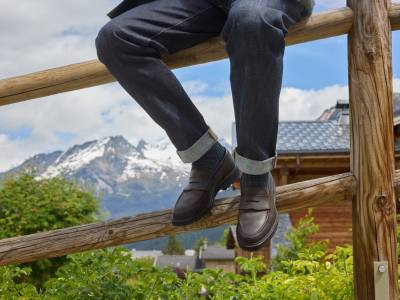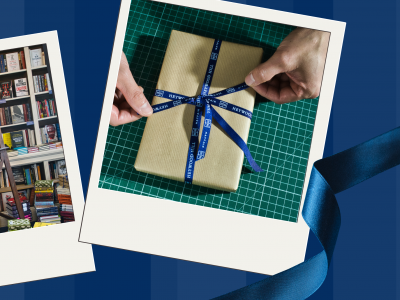It was at 3,500 metres up the side of a snowbound Alpine valley that Crockett & Jones’ head of marketing, James Fox, found himself more pleasantly surprised than he had expected to be. There, to wear-trial a new pair of the boots that the English shoemaker is introducing as part of its autumn/winter 2025 collection, he discovered that they were, “extremely comfortable and extremely good in extreme conditions.” Move over, makers of the more typical clumpy, lumpy specialist hiking boot, with neon accents, Velcro straps and breaking-in blisters. Fox’s cosy feet were not just down to Crockett & Jones’ handmade, Goodyearwelted construction, nor to the boots’ Vibram cleated sole, bellows tongue, reverse storm welt or their insulating, water-repelling membrane layer between the outer leather and the lining. Rather, it was due to the brand’s first use of a side leather made waterproof by the application of a special solution during the tanning process — one that consequently becomes part of the leather rather than sits on top of it, as wax does on a newly polished pair of dress shoes. “That means that even if you scratch the surface of the leather, your boots remain waterproof,” explains Fox.
Inside the Innovative New Designs of Crockett & Jones
30th September 2025
English shoemaker Crockett & Jones continues to follow its own path with innovative new design and materials and clever twists on traditional styles.
Presented by Crockett & Jones.
It took two years of development work to achieve the right balance of wear properties, colour and softness in a typically very stiff leather, one rarely used in footwear and more commonly employed in the making of horse saddles and other tough leather products for which comfort is not a prime consideration. Crockett & Jones has used the leather in two boot styles: the full brogue Islay and Grizedale, a plain-front model that traces its lineage back to the boots the business made for the British Army during the First World War. “Of course, like a Land Rover Defender, only a tiny fraction of these boots will likely ever see a field,” laughs Fox. “They fit into men’s more casual, outdoorsy ways of dressing now. But the point is that, like a Defender, these boots are also fit for purpose and will find customers who want to properly use them as a walking boot — footwear that can really see them through a cold, wet winter.”
Indeed, winter-readiness is an idea Crockett & Jones is now running with. Also launching this September is a collection of super flexible boots, ideal for slipping on after your mountain trek, or, at least, for wearing around the city: the Windermere plain-front, five-eyelet derby; Chepstow three-eyelet chukka; and Elgin low-cut Chelsea boot. These come on the company’s lightest-weight rubber sole and, more unusually, in a dark brown or moss-green waterproof repello suede. For the roughest season? Crockett & Jones argues that, while the common belief that suede is fragile or only suitable for the summer has become deeply ingrained in the style psyche, that’s simply not true. “There’s this notion that if a shoe’s surface is smooth and shiny — like a shell — it has to be more resistant to wear and tear, but that’s not the case. Suede can take a battering and just brushes up to look brand new. And, bonus, you don’t have to polish it,” Fox enthuses. And that’s not the only curveball for the new season: Crockett & Jones is making another counterintuitive twist on winter footwear with the introduction of a new loafer. The Boston 2 is built on a chunky lightweight rubber sole, with a storm welt, one-piece lining and in wax-impregnated rough-out dark brown or green suede. It’s also fully waterproof.
“Everything about the loafer has changed over recent years,” explains Fox. “The time was when it was considered an ‘old man’s shoe,’ and now it’s regarded more as an Ivy League style. The loafer is seen as such an easy shoe to wear — both literally, because you can slip it on, and figuratively, because it works with everything — be it jeans or tailored separates. It’s become a best-selling style for us, but we had never done what you might call a ‘winter loafer’ before. We think the Boston 2 is going to be a big hit.” That, in part, is because styles like these bring just the right touch of newness to otherwise diehard classics, crafted to last a generation thanks to their quality and upgraded materials. They also underscore Crockett & Jones’ position that, contrary to the stance taken by some other English shoemakers, it is — as handsome as its products may be — decidedly not part of the fashion world. As Fox puts it, “Fashion is all about novelty for its own sake, and in a way, suffers from too much of that, which is why its brands go through so many peaks and troughs.”
In contrast, a plain-front derby, for example, will always be a plain-front derby. “We just want to make the best version that there is, by, for example, introducing what’s already a seriously hardy design in a waterproof leather,” Fox says. “It reflects our ethos of pushing forward very gradually, so our footwear remains relevant without adopting radically different, one-season-only aesthetics, while still doing our very best to offer value, which is challenging given the rising costs of manufacturing.”
Indeed, since Crockett & Jones is now the UK’s largest maker of Goodyear-welted, English-made footwear, it feels a responsibility to keep the ship of its industry on a steady course, not least to protect the legacy of a national handcraft recognised worldwide. And it seems to be conquering that mountain too.










